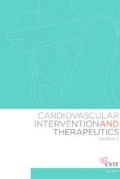Abstract
A sheathless system that inserts a catheter directly into the artery can reduce puncture site-related complications through a 2-Fr reduction of the outer diameter. However, the gap between the dilator and the guiding catheter of the sheathless system is larger than the gap between the dilator and sheath of the introducer system, resulting in stronger insertion resistance. A twisting method with rapid alternating rotation of a device to the left and right during insertion can reduce the insertion resistance. This method can be effective with the sheathless system which has a larger gap. To examine the effect of size reduction on the sheathless system and the effect of insertion resistance reduction using the twisting method, we developed an insertion simulator and compared insertion resistance to a 5-Fr sheath introducer and a 5-Fr sheathless system, with and without the twisting method. The insertion simulator pushed a sheath introducer or a sheathless system toward a mock artery consisted with a 5-mm urethane and a 1-mm rubber sheet by an electrical motor with or without twisting motion generated by a crank shaft. Insertion resistance during the penetration was measured by a tension meter. The insertion resistance was less with the 5-Fr sheathless system than with the 5-Fr sheath introducer. The resistance reduced further with use of twisting for both the sheathed and sheathless catheters. In conclusion, the experiment suggests the benefits of twisting insertion of a sheathless guiding catheter for reduction of puncture site-related complications.




Similar content being viewed by others
References
Kiemeneij F, Laaman GJ, Odekerken D, Slagboom T, van der Wieken R. A randomized comparison of percutaneous transluminal coronary angioplasty by the radial, brachial and femoral approaches: the access study. J Am Coll Cardiol. 1997;29:1269–75.
Mann T, cubeddu G, Bowen J, Schneider JE, Arrowood M et al. Stenting in acute coronary syndromes: a comparison of radial versus femoral access sites. J Am Coll Cardiol. 1998;32:572–76.
Brueck M, Bandorski D, Kramer W, Wieczorek M, Holtgen R, Tillmanns H. A randomized comparison of transradial versus transfemoral approach for coronary angiography and angioplasty. JACC Cardiovasc Interv. 2009;2:1047–54.
Agostoni P, Biondi-Zoccai GG, de Benedictis ML, Rigattieri S, Turri M, Anselmi M, et al. Radial versus femoral approach for percutaneous coronary diagnostic and interventional procedures: systematic overview and interventional procedures. J Am Coll Cardiol. 2004;44:349–56.
Feldman DN, Swaminathan RV, Kaltenbach LA, Baklanov DV, Kim LK, Wong SC, et al. Adoption of radial access and comparison of outcomes to femoral access in percutaneous coronary intervention: an updated report from the national cardiovascular data registry (2007–2012). Circulation. 2013;127:2295–306.
Saito S, Ikei H, Hosokawa G, Tanaka S. Influence of the ratio between radial artery inner diameter and sheath outer diameter on radial artery flow after transradial coronary intervention. Catheter Cardiovasc Interv. 1999;46:173–8.
Pancholy SB, Ahmed I, Bertrand OF, Patel T. Frequency of radial artery occlusion after transradial access in patients receiving warfarin therapy and undergoing coronary angiography. Am J Cardiol. 2014;113:211–4.
Gadkar N. Feasibility and safety of a novel sheath less system during routine percutaneous transradial coronary angiography. Eurointervention. 2011;7 Suppl M:370.
Kwan TW, Cherukuri S, Huang Y, Pancholy S, Daqquati R, Liou M, et al. Feasibility and safety of 7F sheathless guiding catheter during transradial coronary intervention. Catheter Cardiovasc Interv. 2012;80:274–80.
Cheaito R, Benamer H, Hovasse T, Tritar A, Hage F, Garot P et al. Feasibility and safety of transradial coronary interventions using a 6.5-F sheathless guiding catheter in patients with small radial arteries: a multicenter registry. Catheter Caridiovasc Interv. 2015;86:51–8.
Yoshimachi F, Takagawa Y, Terai H, Takahashi A, Shimada Y, Katsuki T et al. A prospective multicenter study using a virtual 3 Fr percutaneous coronary intervention system: the V3 registry. J Invasive Cardiol. (Epub 15 June 2016).
Takeshita S, Saito S. Transradial coronary intervention using a novel 5-Fr sheathless guiding catheter. Catheter Caridiovasc Interv. 2009;74:862–5.
Mizuno S, Takeshita S, Teketani Y, Saito S. Percutaneous coronary intervention using a virtual 3-Fr guiding catheter. Catheter Caridiovasc Interv. 2010;75:983–8.
Author information
Authors and Affiliations
Corresponding author
Ethics declarations
Conflict of interest
The authors have no conflicts of interest concerning the content of the manuscript.
Human and animal rights statement
We complied strictly with the human and animal rights guidelines in this study.
Rights and permissions
About this article
Cite this article
Takagawa, Y., Furukawa, T. Twisting method for reducing friction during insertion of a sheath introducer and a sheathless guiding catheter. Cardiovasc Interv and Ther 33, 40–45 (2018). https://doi.org/10.1007/s12928-016-0431-z
Received:
Accepted:
Published:
Issue Date:
DOI: https://doi.org/10.1007/s12928-016-0431-z




